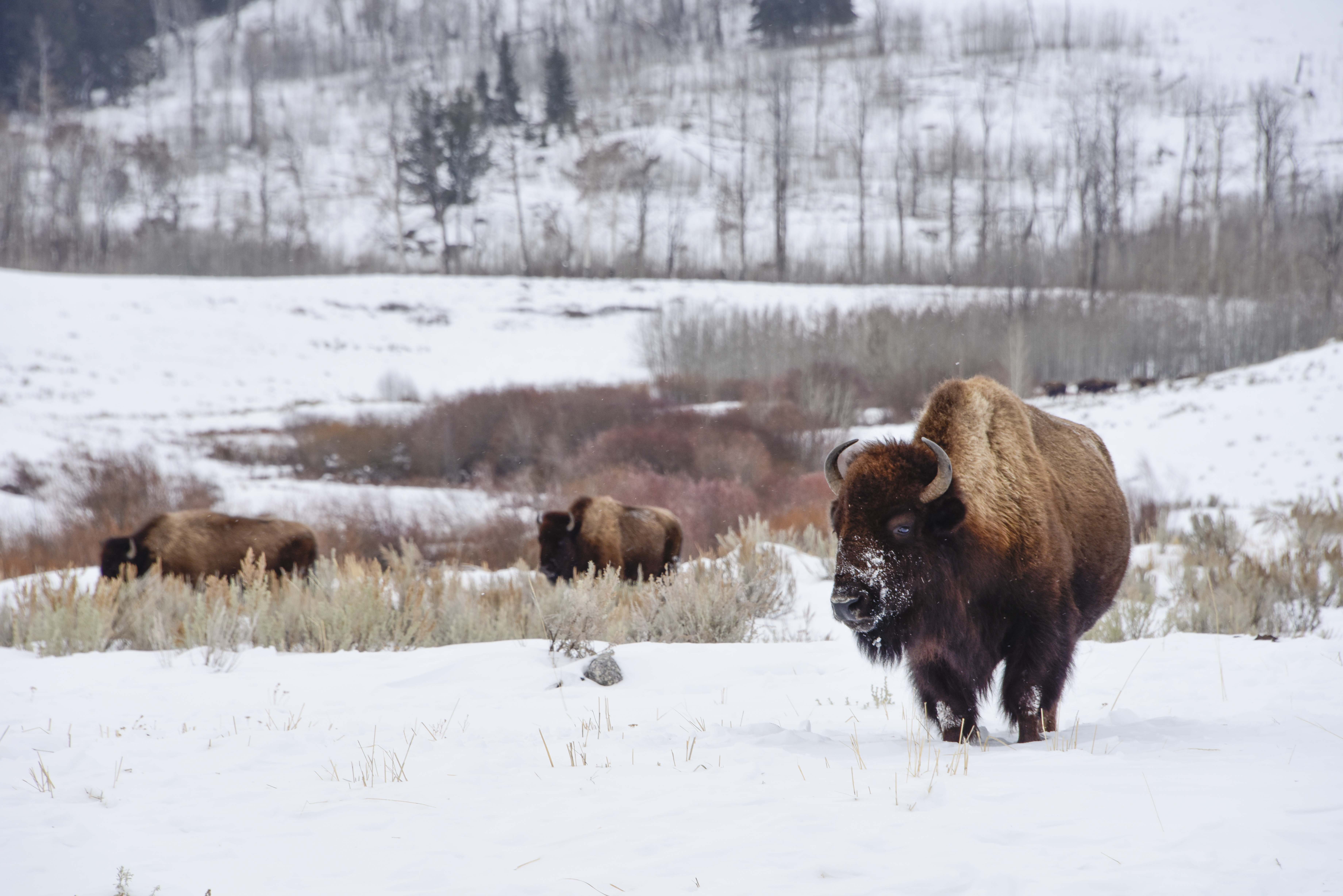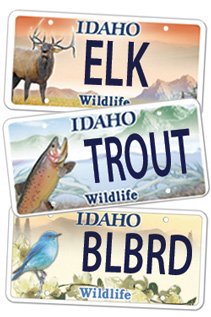Lamar Valley in Winter

Bison were easy to find along the road from Gardiner to Cooke City, Montana in the winter.
Getting into Yellowstone National Park after the roads closed on November 3rd has been problematic. Over the snow tours have started, but unless you are willing to shell out some serious cash to take all your family in a snow coach or rent snowmobiles for everyone, walking or skiing is pretty much your only option. Unless, of course, you are willing to drive a bit.
The highway from Gardiner to Cooke City, along the Yellowstone River then through Lamar Valley, is kept open year-long. It is a bit of a drive from Idaho Falls though and so you will have to plan to spend the night in either Gardiner or Cooke City.
So, what exactly, is a bit of a drive? From Idaho Falls, you drive to Bozeman, Montana, then east to Livingston. This is about a four-and-a-half-hour drive. From Livingston, Gardiner is another 59 miles, or about one and a quarter hours. From there into Lamar and on to Cooke City, it is as long as you want to make it.
We made this trek last week and found a different Yellowstone waiting for us. Mainly the expected crowds just weren’t there. There were vehicles on the road, that is for sure, but once past the bridge over the Gardiner River, we only saw perhaps 20 vehicles per hour. The road was icy in places and we went slow looking for wildlife, and pullouts were numerous and mostly empty.
And we found plenty to look at. In all, the only hoofed mammals we did not see were the mountain goats on Baronette Peak (low clouds prevented us even seeing the mountain), white-tailed deer and pronghorn. Otherwise we saw moose, elk, bison, bighorn sheep and even one mule deer. In addition, we saw coyotes several times and an ermine, but wolves eluded us. Honestly, it was a relief to not have to strain our eyes searching for grizzlies and black bears for a change.
One thing I did not know is that there are a number of cross-country ski trails in this area of the Park. The ranger suggested that the trails are groomed and signs confirmed that. I remember trails at Tower Junction, Baronette Peak, Blacktail Deer Creek and Upper Terrace at Mammoth but I know there were more.
Elk were easiest to find around Mammoth, but we did finally find a small herd at the Tower Junction area above the Roosevelt Lodge and two huge bulls at the entrance to Lamar Valley. Bison were numerous and simple to find. They were scattered from about Phantom Lake through Lamar Valley to Pebble Creek. We saw moose at Soda Butte and bighorns, including a large ram, at the Yellowstone Picnic Area, which is just atop the hill after crossing the Yellowstone River bridge east of Tower Junction on Highway 212 (to Cooke City).
We opted to stay in Gardiner as the Super 8 there was very reasonable compared to places in Cooke City. Also, Cooke City is about 15 miles past Pebble Creek at the far end of Lamar Valley and wasn’t as central as I thought it would be. The Super 8 was a great place to stay ($70 after taxes) with clean remodeled rooms and a large breakfast including ham and scrambled eggs and biscuits and gravy.
Despite poor weather, we really enjoyed our adventure into Yellowstone in winter. We are looking forward to doing it again.
Wildlife License Plates
Great news! as of 2024, there are three NEW designs for license plates. They still are bluebird, cutthroat trout and elk, but they are beautiful.
Idaho Wildlife license plates provide essential funding that benefits the great diversity of native plants and wildlife that are not hunted, fished or trapped—over 10,000 species or 98% of Idaho’s species diversity. Game species that share the same habitats (such as elk, deer, antelope, sage-grouse, salmon, trout) also benefit from these specialty plates.
No state tax dollars are provided for wildlife diversity, conservation education and recreation programs. Neither are any revenues from the sale of hunting or fishing licenses spent on nongame species. Instead, these species depend on direct donations, federal grants, fundraising initiatives—and the Idaho Wildlife license plates.
Both my vehicles have Bluebird Plates. I prefer the bluebird because the nongame program gets 70 percent of the money from bluebird plates, but only 60 percent of the money from elk and trout plates - 10 percent of the money from elk plates supports wildlife disease monitoring and testing programs (to benefit the livestock industry) and 10 percent from cutthroat plates supports non-motorized boat access.
Incidentally, in 2014, the Idaho Legislature denied the Department of Fish and Game the ability to add new plates or even to change the name of the elk and cutthroat plates (very specific) to wildlife and fish plates, a move that would have allowed for changing images occasionally and generating more revenue. It would seem that they believe that we Idahoans don't want a well funded wildlife program.
I think it is time we let the Legislature know that Idahoan support wildlife funding and that we would like to see these generic plates come to fruition.
Help Idaho Wildlife
When we traveled across the state in October 2017, we visited most of the Idaho Department of Fish and Game wildlife management areas. Most of the vehicles we saw using the wildlife management areas did not have wildlife plates. Buying wildlife plates is a great way for non-hunters and hunters alike to support wildlife-based recreation like birding.
C'mon folks, let's help Idaho's wildlife by proudly buying and displaying a wildlife license plate on each of our vehicles!
See below for information on Idaho plates. Most states have wildlife plates so if you live outside Idaho, check with your state's wildlife department or vehicle licensing division for availability of state wildlife plates where you live.
And tell them that you heard about it from Nature-track.com!

Wildlife License Plates
Great news! as of 2024, there are three NEW designs for license plates. They still are bluebird, cutthroat trout and elk, but they are beautiful.
Idaho Wildlife license plates provide essential funding that benefits the great diversity of native plants and wildlife that are not hunted, fished or trapped—over 10,000 species or 98% of Idaho’s species diversity. Game species that share the same habitats (such as elk, deer, antelope, sage-grouse, salmon, trout) also benefit from these specialty plates.
No state tax dollars are provided for wildlife diversity, conservation education and recreation programs. Neither are any revenues from the sale of hunting or fishing licenses spent on nongame species. Instead, these species depend on direct donations, federal grants, fundraising initiatives—and the Idaho Wildlife license plates.
Both my vehicles have Bluebird Plates. I prefer the bluebird because the nongame program gets 70 percent of the money from bluebird plates, but only 60 percent of the money from elk and trout plates - 10 percent of the money from elk plates supports wildlife disease monitoring and testing programs (to benefit the livestock industry) and 10 percent from cutthroat plates supports non-motorized boat access.
Incidentally, in 2014, the Idaho Legislature denied the Department of Fish and Game the ability to add new plates or even to change the name of the elk and cutthroat plates (very specific) to wildlife and fish plates, a move that would have allowed for changing images occasionally and generating more revenue. It would seem that they believe that we Idahoans don't want a well funded wildlife program.
I think it is time we let the Legislature know that Idahoan support wildlife funding and that we would like to see these generic plates come to fruition.

"WOW. What a phenomenal piece you wrote. You are amazing." Jennifer Jackson
That is embarrassing, but actually a fairly typical response to my nature essays. Since The Best of Nature is created from the very best of 16 years of these nature essays published weekly in the Idaho Falls Post Register (online readership 70,000), it is a fine read. It covers a wide variety of topics including humorous glimpses of nature, philosophy, natural history, and conservation. Readers praise the style, breadth of subject matter and my ability to communicate complex and emotional topics in a relaxed and understandable manner.
Everyone can find something to love in this book. From teenagers to octogenarians, from the coffee shop to the school room, these nature essays are widely read and enjoyed.
Some of the essays here are my personal favorites, others seemed to strike a chord with readers. Most have an important message or lesson that will resonate with you. They are written with a goal to simultaneously entertain and educate about the wonderful workings of nature. Some will make you laugh out loud and others will bring a tear to the eye and warm your heart.
Readers Write:
"You hit a home run with your article on, Big Questions in Nature. It should be required reading for everyone who has lost touch with nature...great job!" Joe Chapman
"We enjoyed your column, Bloom Where Planted. Some of the best writing yet. The Post Register is fortunate to have your weekly columns." Lou Griffin.
To read more and to order a copy, click here or get the Kindle version
Copies are also available at:
Post Register
Island Park Builders Supply (upstairs)
Barnes and Noble in Idaho Falls
Harriman State Park, Island Park
Museum of Idaho
Valley Books, Jackson Wyoming
Avocet Corner Bookstore, Bear River National Wildlife Refuge, Brigham City, Utah
Craters of the Moon National Monument Bookstore, Arco, Idaho